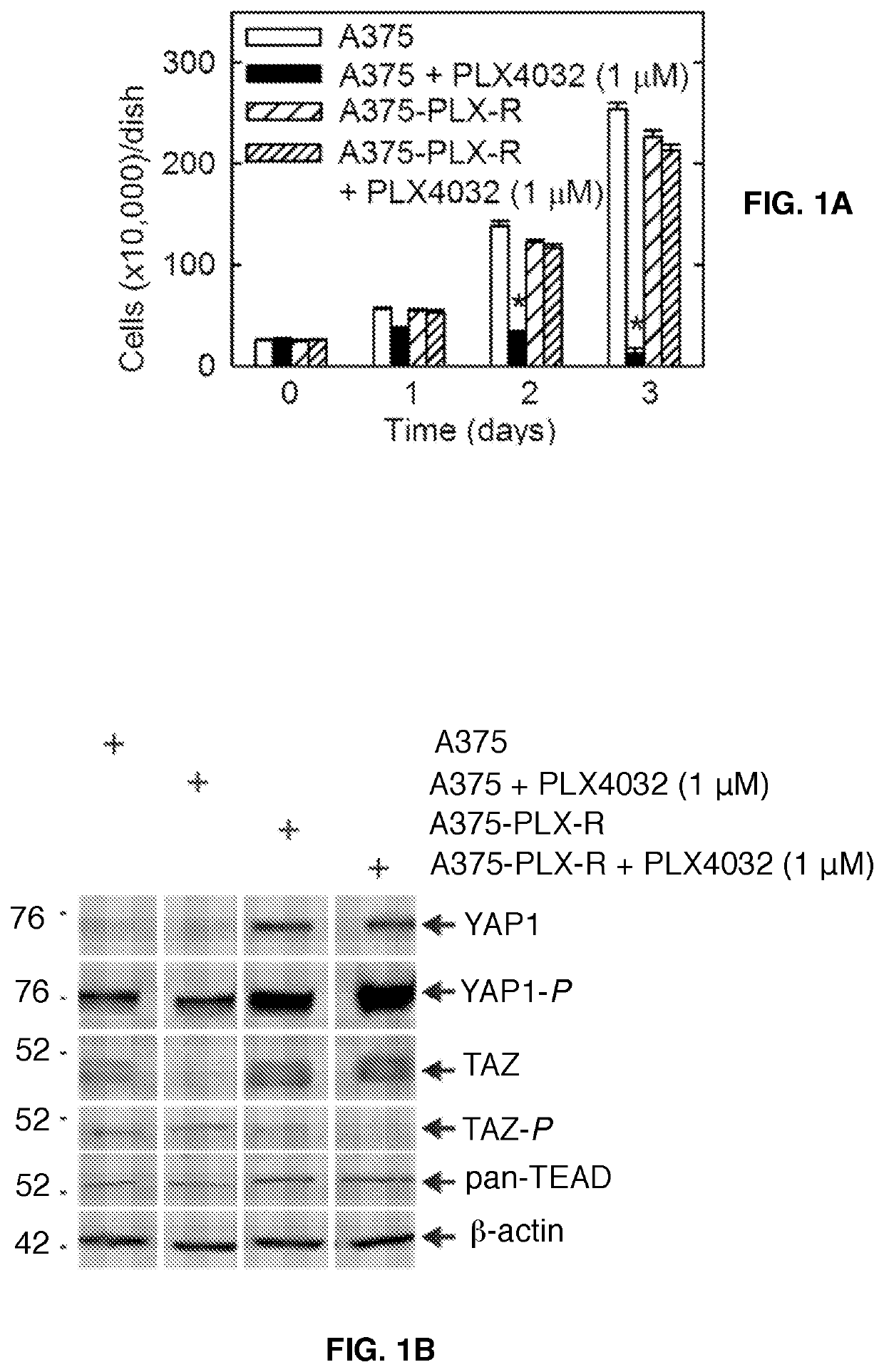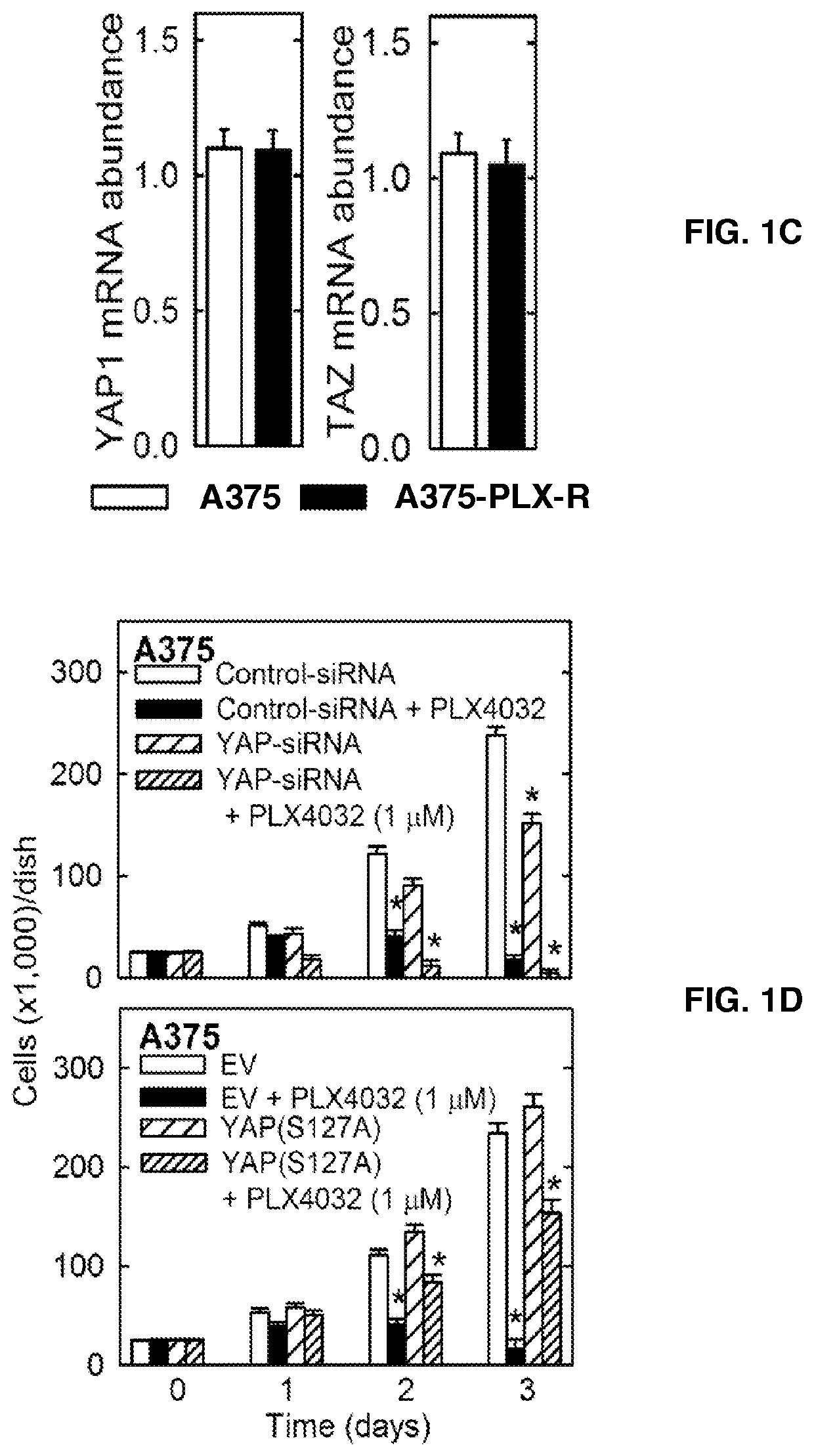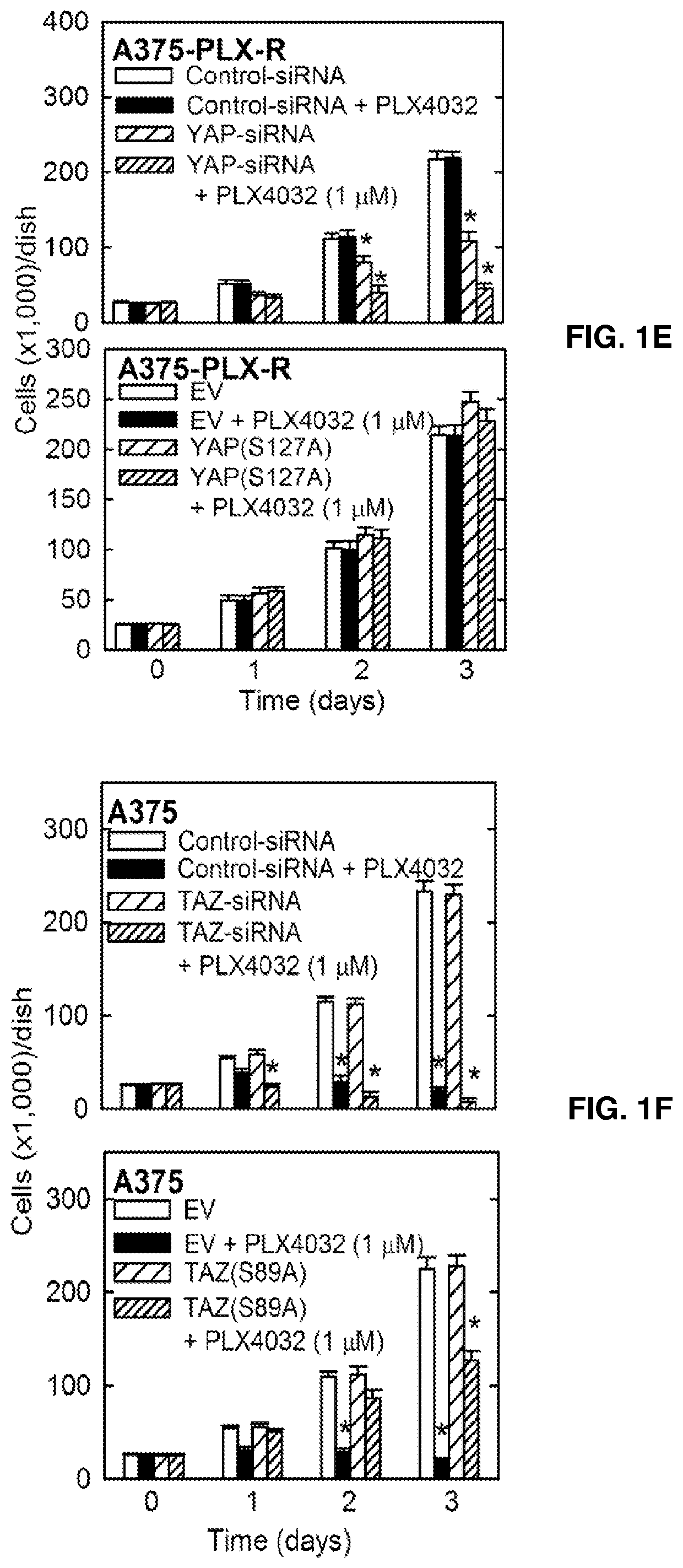Methods of Treating Resistant Cancers
a cancer and resistance technology, applied in the field of cancer therapy, can solve the problems of insufficient art for optimal methods to reverse the resistance of braf inhibitors in cancer treatment, and achieve the effect of reducing resistan
- Summary
- Abstract
- Description
- Claims
- Application Information
AI Technical Summary
Benefits of technology
Problems solved by technology
Method used
Image
Examples
example 1
Materials and Methods
Antibodies and Reagents
[0041]Sodium pyruvate (11360-070), Dulbecco's Modified Eagle's Medium (DMEM) (11960-077), 0.25% trypsin-EDTA (25200-056) and L-Glutamine (25030-164) were purchased from Gibco (Grand Island, N.Y.). Heat inactivated fetal calf serum (FCS, F4135), anti-b-actin (A5441) and lactacystin (L6785) were purchased from Sigma (St. Louis, Mo.). Cell lysis Buffer (9803) and antibodies for ERK1 / 2 (9102) ERK1 / 2-P (9101), YAP1 (4912), YAP1-P (13008), TAZ (4883) pan-TEAD (13295), p21Cip1 (2947), cleaved PARP (9541), caspase-8 (9746) and caspase-9 (9502) were from Cell Signaling Technologies (Danvers, Mass.). Antibodies to cyclin A (SC-751), cyclin B (SC-245) p27 (SC-1641) and TAZ-P (SC-17610-R) were purchased from Santa Cruz (Dallas, Tex.). YAP1 (52771) antibody for immunofluorescence was purchased from Abcam (Cambridge, Mass.). YAP1-siRNA (S102662954, S104438651, S104438644, S104438637) were purchased from Qiagen (Valencia, Calif.). Control- (37007) and TA...
example 2
YAP1 and TAZ are BRAF Inhibitors Resistance Factors
[0050]PLX4032 is an important BRAF(V600E)-targeting drug used for the treatment of melanoma that is commercially available as vemurafenib (4). PLX4032 is highly effective in the short-term, but the tumors eventually become resistant (4, 19). As models to study PLX4032 drug resistance, BRAF(V600E)-positive / PLX4032-sensitive A375 cells were used and created PLX4032-resistant cells (e.g., A375-PLX-R) were created by selection in PLX4032 containing medium. FIG. 1A shows that, unlike A375 cells, proliferation of A375-PLX-R cells is not suppressed by PLX4032. To understand the mechanism of resistance, the YAP1 and TAZ transcription adaptor proteins and the TEAD transcription factors were confirmed to have a role in drug resistance (12,13,20-24). FIG. 1B shows that YAP1, TAZ and TEAD levels are increased in A375-PLX-R cells and that the increase in YAP1 level is associated with an increase in apparent YAP1 phosphorylation. FIG. 1C shows th...
example 3
Role of YAP1 and TAZ in MCS Cells
[0052]MCS cells can be selected by growth as spheroids and form rapidly growing, invasive and highly aggressive tumors as compared to non-stem melanoma cancer cells (26). The impact of PLX4032 treatment on MCS cell spheroids was examined. FIGS. 2A-2B shows that PLX4032 treatment suppressed A375 cell, but not A375-PLX-R cell, spheroid formation. FIG. 2C shows that A375-PLX-R cell-derived MCS cells expressed elevated YAP1, TAZ and TEAD levels as compared to A375 cell derived MCS cells. In addition, YAP1-P formation was increased, and TAZ-P formation reduced. These results are generally consistent with observations in monolayer culture (FIGS. 1A-1I). Subcellular distribution is reported to influence YAP1 and TAZ activity in some cell types and so it was determined if PLX4032 treatment influences YAP1 / TAZ subcellular distribution. As shown in FIG. 2D, there was no major change in YAP1 intracellular distribution in control versus PLX4032-treated A375 cell...
PUM
| Property | Measurement | Unit |
|---|---|---|
| volume | aaaaa | aaaaa |
| time | aaaaa | aaaaa |
| diameter | aaaaa | aaaaa |
Abstract
Description
Claims
Application Information
 Login to View More
Login to View More - R&D
- Intellectual Property
- Life Sciences
- Materials
- Tech Scout
- Unparalleled Data Quality
- Higher Quality Content
- 60% Fewer Hallucinations
Browse by: Latest US Patents, China's latest patents, Technical Efficacy Thesaurus, Application Domain, Technology Topic, Popular Technical Reports.
© 2025 PatSnap. All rights reserved.Legal|Privacy policy|Modern Slavery Act Transparency Statement|Sitemap|About US| Contact US: help@patsnap.com



